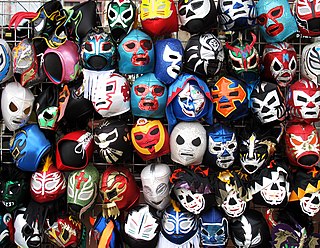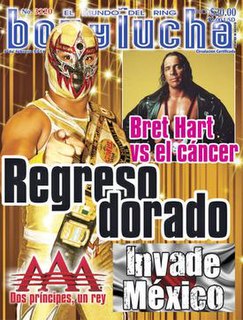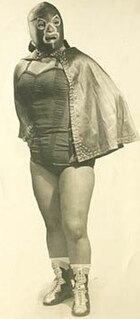
A wrestling mask is a fabric based mask that some professional wrestlers wear as part of their in-ring persona or gimmick. Professional wrestlers have been using masks as far back as 1915 and they are still widely used today, especially in Lucha Libre in Mexico.

Lucha libre is the term used in Mexico for professional wrestling. Since its introduction to Mexico in the early 20th century, it has developed into a unique form of the genre, characterized by colorful masks, rapid sequences of holds and maneuvers, as well as "high-flying" maneuvers, some of which have been adopted in the United States and elsewhere. The wearing of masks has developed special significance, and matches are sometimes contested in which the loser must permanently remove his mask, which is a wager with a high degree of weight attached. Tag team wrestling is especially prevalent in lucha libre, particularly matches with three-member teams, called trios.

Alejandro Muñoz Moreno, better known by the ring name Blue Demon, was a Mexican film actor and luchador enmascarado. Blue Demon is considered a legend of lucha libre, partially from starring in a series of Lucha films between 1961 and 1979, often alongside in-ring rival El Santo. His in-ring career began in 1948 and stretched for 41 years until his retirement in 1989.

Luchador films are Mexican professional wrestling/action/science-fiction/horror films starring some of the most popular masked luchadores in Lucha Libre. The luchadores are portrayed as superheroes engaging in battles against a range of characters from spies, to vampires and Martians. These films were low-budget and produced quickly. Nearly all lucha films included fist-fighting and wrestling action sequences in and out of the ring which were choreographed and performed by the stars themselves without the aid of stunt doubles. The genre's popularity peaked during the mid-1960s to early-1970s. At least 150 luchador films were produced starting with the 1952 film Huracán Ramírez.
Máximino Linares Moreno was a Mexican luchador and lucha film star, better known under the ring name Rayo de Jalisco. He is considered to be one of the best wrestlers of his generation. Linares' son followed in his footsteps and is working under the name Rayo de Jalisco Jr., wearing the same distinctive black mask with silver lightning bolt on it when wrestling. One of Linares' grandsons is also a wrestler, known as "Rayman".

Jesús Reza Rosales is a Mexican Luchador, or professional wrestler, best known under the ring name Mano Negra. Mano Negra is Spanish for "The Black Hand" and is taken from the Spanish anarchist organisation La Mano Negra. Rosales is a former two time holder of the NWA World Welterweight Championship, two time holder of the NWA World Light Heavyweight Championship, and the Mexican National Light Heavyweight Championship while working for Empresa Mexicana de Lucha Libre (EMLL). He also worked for the Universal Wrestling Association (UWA) where he held the UWA World Junior Light Heavyweight Championship and for the World Wrestling Association (WWA) where he held the WWA Lightweight Championship. Mano Negra was originally an Enmascarado, or masked wrestler, but lost a Lucha de Apuesta, bet match, to Atlantis in the main event of CMLL's 60th Anniversary Show and was forced to unmask.
¡Que viva la lucha! is a 2007 film directed and produced by Gustavo Vazquez about Lucha libre in Tijuana, Mexico, considered to be a form of extreme lucha libre. The film follows Extreme Tiger, an up-and-coming professional luchador from Tijuana, on a journey that places him in a mask vs. hair match against Joe Líder. In addition, he follows other new talent, Angel Negro Jr. and Pancho Cachondo. In the process, the film also interviews other luchadores, promoters, commissioners, families, and fans who discuss the cultural significance of lucha libre as sport, ritual, and spectacle. The film includes music by Carne Cruda, Marziano, White Pine, and Nortec Collective. ¡Que viva la lucha! premiered at the 30th annual Mill Valley Film Festival on Saturday, Oct. 13, 2007, and has won two awards; at the Latino Film Festival and at the San Francisco International Film Festival.

In lucha libre, an exótico is a luchador fighting/performing in drag. The exótico’s movement vocabulary is campy, often silly, and seldom dignified. Exóticos are male wrestlers who appropriate feminine aspects in their wrestling personas or "gimmicks" – through feminine costumes, for example, ‘contesting the dramatic representation of machismo’ and successfully unmanning their opponents in the ring while also ‘rejecting the outward signs of manhood’. Though exoticos may not necessarily be gay, they often are, and their sexual ambiguity is undeniable. Attired with feather boas, headdresses, sequins or stockings, they defy a religious Latin culture that is ardently macho.
Heather Levi is an American anthropologist best known for her research in lucha libre. Levi was born in Massachusetts and became an Assistant professor of Anthropology at Temple University. She received her Bachelor of Arts degree in Anthropology from the University of Massachusetts in 1990 and went on to receive a PhD in Anthropology in 2001 from New York University. She currently lives in Philadelphia.

Ruleta de la Muerte (2012) was an annual professional wrestling major event produced and scripted by the Mexican professional wrestling promotion International Wrestling Revolution Group (IWRG), which took place on September 6, 2012 in Arena Naucalpan, Naucalpan, State of Mexico, Mexico. The focal point of the event was the eponymous Ruleta de la Muerte eight-man tournament where all participants put their wrestling mask or hair on the line. The Ruleta de la Muerte tournament is a Lucha libre stable, a tournament which unlike traditional tournaments it is the loser that advances in the tournament, advancing to the final that is contested under Luchas de Apuestas or bet rules.

Ruleta de la Muerte was an annual professional wrestling major event produced and scripted by the Mexican professional wrestling promotion International Wrestling Revolution Group (IWRG), which took place on May 5, 2015 in Arena Naucalpan, Naucalpan, State of Mexico, Mexico. The event was named after the Maine vent match, the Ruleta de la Muerte, a steel cage match where all four of the competitors were chained together. The last man in the cage would be forced to have his hair shaved off as a result. The four competitors risking their hair in the match were Ricky Cruz, Eterno, Veneno and X-Fly. The show featured four additional matches.

Promo Azteca was a professional wrestling promotion that was founded in Tijuana, Mexico, by Fuerza Guerrera in 1995. It was taken over by Konnan and Jorge Rojas the following year and was home to many of the luchadors wrestling for World Championship Wrestling (WCW) during the late-1990s.
In Lucha libre, the Mexican version of professional wrestling, the Ruleta de la Muerte is a type of professional wrestling tournament where the loser or losers of a match would advance in the tournament instead of the winners. The finals of a Ruleta de la Muerte tournament featured the losing teams wrestle each other under Lucha de Apuestas, or "bet match" rules, where the loser would be forced to either unmask or have all their hair shaved off as a result. Various Mexican promotions have held Ruleta de la Muerte tournaments; some like International Wrestling Revolution Group have held these tournaments on a regular basis.
The Mexican professional wrestling promotion International Wrestling Revolution Group produced and scripted a Ruleta de la Muerte tournament on November 5, 2009. The show took place in Arena Naucalpan, in Naucalpan, State of Mexico, Mexico, IWRG's main venue and the site of the majority of all their major shows and tournaments.
The Mexican professional wrestling promotion International Wrestling Revolution Group produced and scripted a Ruleta de la Muerte tournament on October 27, 2013. The show took place in Arena Naucalpan, in Naucalpan, State of Mexico, Mexico, IWRG's main venue and the site of the majority of all their major shows and tournaments.

Súper Luchas is a Spanish-language publication covering lucha libre and other forms of professional wrestling. The publication began as a print magazine in 1991 and later became the largest lucha libre magazine in the world and remained one of the few professional wrestling magazines to survive to the 2000s but now operates mainly as an online website. The website is the number one Spanish-language professional wrestling website in the world.

Box y Lucha is a Spanish language magazine and website. It is the oldest lucha libre magazine still in existence and one of the first ones to be published. It also covers boxing and other martial arts.
Javier Márquez Gómez Is a Mexican professional wrestler, performing under the ring name Dulce Gardenia, currently working for Consejo Mundial de Lucha Libre (CMLL) as a tecnico/face. As Gardenia, Márquez portrays an exótico character, who is presented as effeminate and homosexual in the ring. Márquez's personal sexual preferences have not been made public and not all exótico are homosexuals. His ring name is in part an homage to Dizy Gardenia who was one of the earliest exótico wrestlers in the 1940s.

Magdalena Caballero was a Mexican luchadora, or professional wrestler commonly known under her ring name La Dama Enmascarada. Caballero was a relative of professional wrestler Irma González as well as González's daughter Irma Aguilar although it is unclear exactly how they were related.














